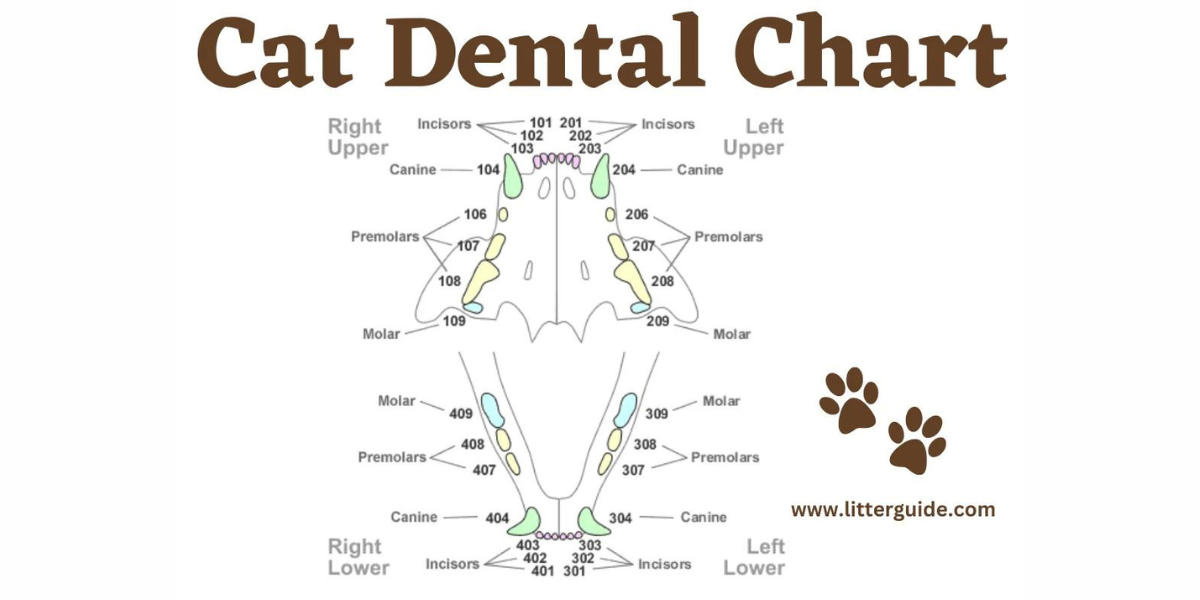Cats, like humans, have a complex dental structure that plays a crucial role in their overall health. Understanding your cat’s dental anatomy can help you maintain their oral hygiene and prevent dental issues. This article provides a detailed guide to the cat dental chart, helping you identify and care for each type of tooth in your feline friend’s mouth.
Why is Cat Dental Health Important?
Health Implications
Dental health is essential for a cat’s overall well-being. Poor dental hygiene can lead to:
- Periodontal Disease: Infections that affect the structures around the teeth.
- Tooth Loss: Due to decay and gum disease.
- Pain and Discomfort: Dental issues can cause significant pain.
- Systemic Health Issues: Bacteria from the mouth can enter the bloodstream and affect other organs.
Signs of Dental Problems
Common signs that your cat might have dental issues include:
- Bad breath
- Difficulty eating
- Drooling
- Pawing at the mouth
- Red, swollen gums
Understanding the Cat Dental Chart
Deciduous Teeth (Baby Teeth)
Kittens have 26 deciduous teeth that begin to erupt at about 2-3 weeks of age. These teeth are temporary and will be replaced by permanent teeth.
Deciduous Teeth Breakdown
- Incisors: 12 (6 upper, 6 lower)
- Canines: 4 (2 upper, 2 lower)
- Premolars: 10 (6 upper, 4 lower)
Permanent Teeth
Adult cats have 30 permanent teeth that replace their deciduous teeth between 4-6 months of age.
Permanent Teeth Breakdown
- Incisors: 12 (6 upper, 6 lower)
- Canines: 4 (2 upper, 2 lower)
- Premolars: 10 (6 upper, 4 lower)
- Molars: 4 (2 upper, 2 lower)
Detailed Tooth Description
- Incisors
- Location: Front of the mouth, upper and lower jaw.
- Function: Grasping and grooming.
- Total: 12 (6 upper, 6 lower).
- Canines (Fangs)
- Location: Just behind the incisors, upper and lower jaw.
- Function: Tearing food and defense.
- Total: 4 (2 upper, 2 lower).
- Premolars
- Location: Behind the canines.
- Function: Shearing and grinding food.
- Total: 10 (6 upper, 4 lower).
- Molars
- Location: Behind the premolars.
- Function: Grinding food.
- Total: 4 (2 upper, 2 lower).
Cat Dental Care Tips
Regular Check-ups
Schedule regular veterinary check-ups to monitor your cat’s dental health. Professional cleanings may be necessary to prevent plaque and tartar build-up.
Home Dental Care
Brushing Your Cat’s Teeth
- Toothbrush: Use a cat-specific toothbrush or a soft-bristled human toothbrush.
- Toothpaste: Always use toothpaste designed for cats. Human toothpaste can be harmful.
Steps to Brush Your Cat’s Teeth
- Introduce the Brush: Let your cat sniff and get used to the toothbrush.
- Apply Toothpaste: Put a small amount of cat toothpaste on the brush.
- Brush Gently: Lift your cat’s lip and gently brush the teeth and gum line.
- Reward: Give your cat a treat or praise after brushing.
Dental Diet and Treats
Provide your cat with dental treats and a diet designed to reduce plaque and tartar build-up. Specialized dental foods can help maintain oral hygiene.
Dental Toys
Chew toys designed for cats can help clean their teeth and massage their gums, reducing the risk of dental disease.
Common Dental Issues in Cats
Gingivitis
Inflammation of the gums caused by plaque build-up. It can lead to more severe periodontal disease if untreated.
Periodontal Disease
An advanced stage of gum disease that affects the tissues supporting the teeth. It can result in tooth loss and other health problems.
Tooth Resorption
A condition where the tooth structure breaks down, leading to pain and potential tooth loss. It is common in cats and requires veterinary attention.
Fractured Teeth
Cats can fracture their teeth due to trauma or chewing on hard objects. Fractured teeth can be painful and may require extraction.
Conclusion
Understanding the cat dental chart and the importance of dental care is vital for maintaining your feline friend’s overall health. Regular check-ups, proper home dental care, and a diet that promotes oral health can help prevent dental issues and ensure your cat remains healthy and happy.
